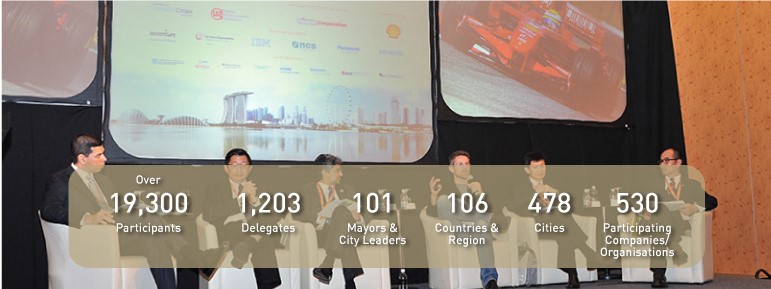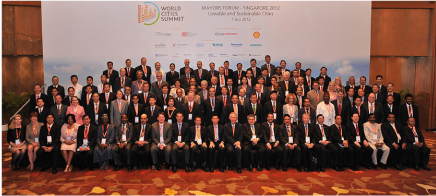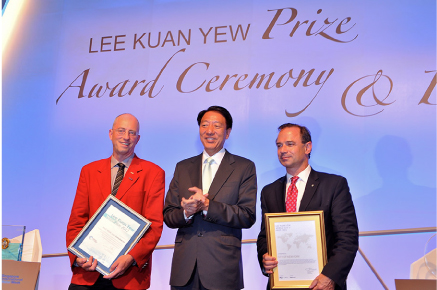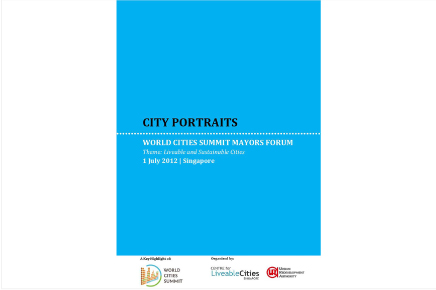Home >
About Us >
Past Editions >
World Cities Summit 2012
World Cities Summit 2012

Themed “Liveable and Sustainable Cities—Integrated Urban Solutions”, the 3rd World Cities Summit (WCS) 2012 explored how cities can build resilience and improve their quality of life and environment by adopting integrated solutions to increasingly complex challenges. For the first time, the Summit was co-located with the Singapore International Water Week and the CleanEnviro Summit Singapore.
The concerns highlighted at the Summit related to how cities could be made green, good and growing; how cities could be designed to deliver a life full of opportunities for growth and exploration, with room for thought and experimentation and spaces for recreation and diversity; and, how citizens could enjoy, both, the fruits of economic progress, as well as a future that preserves the wealth of the earth and sustains a high quality of life.
Living up to its spirit of sharing and learning, discussions at the Summit were organised under eight Urban Solution Tracks: Intense Cities, Eco Cities, Biodiverse Cities, Smart Cities, Mobile Cities, Resilient Cities, Inclusive Cities, and Investing in Cities, along with four In-Focus Forums.
MAYORS FORUM

Cities around the world have common challenges. At the WCS Mayors Forum 2012, more than 100 mayors and city leaders drew inspiration from each other’s experiences and shared lessons that reflect a diversity of social, cultural and economic cityscapes.
The common challenges faced by city leaders were discussed in smaller breakout sessions. Five of these centred on key themes from the Centre of Liveable Cities Framework for Liveable and Sustainable Cities: achieving a high quality of life; maintaining a competitive economy; ensuring a sustainable environment; integrated master planning and development; and dynamic urban governance. There was also a session on building liveable
cities. While the challenges are common across cities, each city is different and based on its
needs, priorities and stages of development, and requires customised solutions. Focusing on the medium- to long-term policies and planning is, therefore, crucial to the pursuit of sustainable development.
LEE KUAN YEW WORLD CITY PRIZE
LAUREATE CITY: NEW YORK CITY

New York City was awarded the 2012 Lee Kuan Yew World City Prize for its ability to recover from the traumatic 9/11 attacks and transform itself into a city of parks, pedestrian zones and fruitful partnerships between planners, private investors and community groups. Embracing its complexity, density and diversity, the city witnessed a marked increase in the quality of life in a short span of time.
URBAN SOLUTIONS THEMATIC TRACKS
Track 1: INTENSE CITIES: Achieving levels of urban intensity, not merely density
A densely populated city does not necessarily mean it has achieved a level of urban intensity, which is measured by the quality and depth of interactions, the diversity of activities, and the power of places to inspire people and spark a unique ‘buzz’. Key insights:
- Arts and culture are a part of intense cities.
- Greenery and heritage play a role in conveying depth.
- Conserving natural and built heritage can instil a sense of home and belonging.
- Business districts can be transformed into areas where people can live, dine, play and interact.
- Intensity and sustainability have to go together.
Track 2: ECO CITIES: Fad or a sustainable option?
The discussion focused on whether cities have lived up to the concept of eco-cities and what are they doing to make life more sustainable and eco-friendly. Key insights:
- Cities don’t have to start from scratch as technologies for sustainable lifestyles already exist.
Planners can help drive change in the corporate sector by removing barriers, creating level playing fields and promoting innovation.
- Policy integration and alignment between government bodies are crucial to ensure that growth is inclusive at the city level.
- Singapore has approached the planning of an eco-city by integrating the goals of economic, social and environmental sustainability.
Track 3: BIODIVERSE CITIES: Sustaining a model of co-existence
What can cities do to ensure that biodiversity is protected amid urban developments? Key insights:
- Cities need not be viewed as a threat to biodiversity but as part of the solution.
- Singapore is a city where much biodiversity exists amidst an urban environment.
- Buildings should not be separated from nature but become part of it.
- Biophilic cities will have community gardens and incorporate nature into the design of buildings.
Track 4: SMART CITIES: Harnessing data and technology, improving efficiency
The session explored the current approaches, models and best practices of intelligent cities, and how information technologies are shaping their infrastructure and people’s behaviour. Key insights:
- Harnessing technology and data should be the main thrust of smart cities.
- Smart cities must have a high living standard that is affordable and reliable; offer a conducive business environment and efficient government services for all.
- Smart cities are responsive to citizens.
- Smart cities need technologies to make sense of data for making better decisions.
- Smart and sustainable cities require solutions where energy savings play a part in energy creation.
Track 5: MOBILE CITIES: In search of new urban mobility models
As road congestion reaches breaking point, how can cities maintain mobility and sustain the investments needed to drive new urban transport models? Key insights:
- Liveable cities are only possible with public transport.
- New transport links can help cities expand their economic space beyond traditional boundaries, connecting people, companies and minds through technology and, increasingly, green modes of transportation.
- Raising the cost of car ownership is key to getting people to use public transport.
Track 6: RESILIENT CITIES: Designing system-wide responses to external forces
Beyond promoting economic growth and efficiency, cities have recognised the need to develop strategies to mitigate the effects of climate change and extreme weather patterns on their urban landscapes. New approaches are required to increase the resilience of energy and water systems and build the adaptive capacity of cities and communities. Key insights:
- Creating resilient cities requires an understanding of complex urban systems consisting of the physical environment as well as social and economic systems.
- Resilience is the capacity to absorb both planned and unplanned changes, as well as the flexibility to respond and adapt.
- Collaboration with corporations, the public and the international community is also vital, as climate change is a global issue.
Track 7: INCLUSIVE CITIES: Supporting & integrating a productive ageing community
Can city infrastructure and other services ensure that older citizens are active, mobile, healthy and connected with the community? What can be done to create a “city for all ages”? Key insights:
- Aging is an irreversible trend and cities must create age-friendly environments to foster the health and social participation of older people.
- Barriers to inclusiveness include governance models that fail to take into account local-level issues as well as old and new infrastructure.
- Beyond comfort and privacy, the elderly want to remain part of the community and not be marginalised.
- Technology can address the needs of senior citizens by tackling healthcare costs; helping them live independently, actively and meaningfully; and by providing security and connectedness with the world.
Track 8: INVESTING IN CITIES: Re-inventing and sustaining cities through public-private partnerships
The session looked at some of the new operating models, opportunities and challenges for investment in emerging markets and cities. Key insights:
- Cities with the ability to continually upgrade their infrastructure are favourable for long-term investments.
- Public-private partnerships can serve to transfer the capital cost of a project to a private partner, lower its operating costs or reduce its risks. Given clear rules and transparent structures, such projects can have a powerful economic effect.
- To make public-private partnerships work it is important to set the rules and get the framework right.
